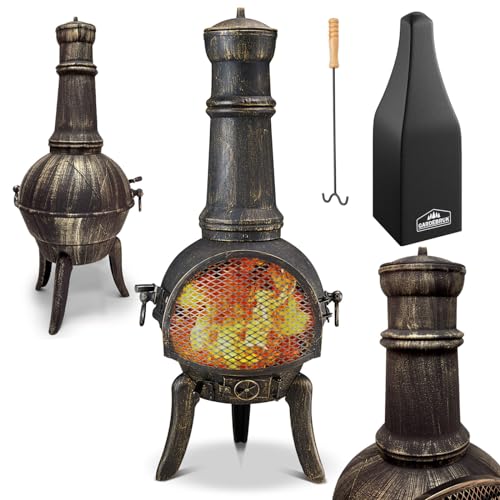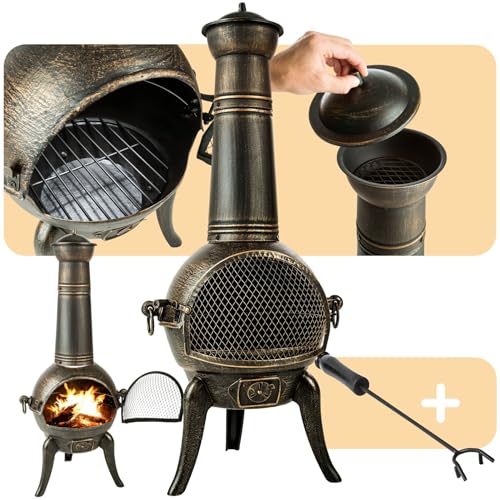What's The Job Market For Chimineas And Fire Pits Professionals Like?
페이지 정보

본문
 Choosing Between Chimineas and Fire Pits
Choosing Between Chimineas and Fire PitsThe choice between a biggest chiminea and a fire pit will depend on your personal aesthetic preferences and the overall layout of the garden. Chimineas are a classic design that will complement rustic outdoor decor. Fire pits, on the other hand, have clean lines and fit in with modern garden designs.
 Fire pits should be kept away from materials that are flammable for safety reasons. Chimineas, on the other hand are able to cook and are safe due to their enclosed design, even in windy weather.
Fire pits should be kept away from materials that are flammable for safety reasons. Chimineas, on the other hand are able to cook and are safe due to their enclosed design, even in windy weather.Aesthetics
Chimineas and fire pits can bring warmth to any outdoor space. The best choice depends on your aesthetic tastes and space requirements. Fire pits have more flexibility in design than chimineas sale, but are more expensive, such as maintenance and fuel. However, chimineas offer more traditional appearance with controlled heat and smoke. Understanding the differences between both choices, and evaluating your needs are the initial steps to choosing the best American-made chiminea.
Chimineas are freestanding front-loading outdoor ovens or fireplaces that have vertical vents (or chimney). Chimineas are typically constructed from clay or terracotta, as well as cast iron. They can also be found in steel, metal, or cast iron. Chimineas made of clay are more traditional and can be very decorative however they require careful handling due to their fragility. Metal versions are more durable and can withstand higher temperatures.
The unique design of the chiminea directs smoke upwards, away those who are seated around it. This is a great choice for small spaces where controlling smoke is essential. The open top makes them simpler to maintain and they can be used in conjunction with grills to cook. They are also safer than fire pits since they don't create as many sparks.
Fire pits, on the other hand, are designed to permit the full combustion of wood. They can also be used with different fuel types. They are popular for backyard patios and can be set up close to seating areas. They can burn standard-sized logs, as well as small branches and twigs for more controlled flames.
The initial investment and ongoing expenses are two crucial factors to consider when deciding between a chiminea barbecue or a fire pit. While a chiminea may cost more initially but its durability and ease of use may reduce long-term costs. On the other hand a fire pit could be less expensive, but it will require more frequent maintenance and replacement parts. Furthermore, a chiminea might have a less negative environmental impact because of its controlled burn and less smoke, whereas fire pits can produce more smoke and emissions.
The output of heat
The amount of heat produced by a chiminea garden will depend on its size, the type of wood it uses and the manner in which it is placed in the fire. Dry well-seasoned wood will generate more heat than green or damp wood. Also, a well-positioned chiminea that is not blocked by trees or other structures will get more sun's heat than one that is shaded. The chimney of a chiminea can help to direct more heat into the air, especially when the funnel design is used.
While both provide warmth to those seated around them, the perception of warmth may differ significantly. How warm you feel depends on a variety of factors, including the type of clothing worn as well as your metabolism, among other physical factors. However, regardless of these variables the chimineas remain the ideal source of warmth for small groups or intimate gatherings.
Chimineas are distinguished by their wide base, and an open chimney which draws air into the unit to fuel it. They can be constructed from clay, terracotta cast iron, or steel, with the metal models typically being able to withstand high temperatures and less susceptible to rust. Chimineas made of clay and terracotta have a more traditional look, but they tend to crack over time and require special attention. Cast iron models are more robust and are suitable for cooking food. They also have the capacity to hold larger logs.
In addition to being a great decorative feature in addition to being a great feature for your home, these units are great to heat outdoor spaces and can be set up on the patio or in the backyard to create a cozy ambience. Many homeowners opt to connect a chiminea to grills to enhance cooking capabilities.
Fire pits, on the other hand they have a smaller opening inside the body, which restricts the dimensions of the logs that can be used. These units are also more likely to generate a lot of stray sparks, so they must be stored in a safe area. In general, a fire pit is best suited for large outdoor areas where there are a lot of people who will enjoy its warmth as the sun sets.
Smoke control
If you're looking to add an instant rustic look to your garden or patio, a chiminea can help create a welcoming place to spend time with friends and family. It was traditionally used for heating and cooking, these decorative fireplaces come in various materials, including traditional clay and modern cast iron models. They are situated close to the ground, and have an open flame that draws in oxygen to burn, while keeping smoke out of reach of people.
Chimineas radiate heat to the outside from the front opening to provide warmth to those who sit near it. However the chimney stack may be quite low and therefore generate lots of wood smoke, particularly when burning logs that aren't fully well-seasoned. Carbon monoxide, a colourless and odourless gas, may build up if the logs are not fully seasoned. This can be prevented by using hardwood that has been seasoned or even fuel alternatives such as bioethanol.
Fire pits are open from all sides and allow the heat to be felt in the 360-degree radius. They do, however, produce a significant amount of smoke depending upon the wind direction and size of the logs. Pick a model with a double-wall design to increase airflow and minimise smoke emissions.
Both chimineas and fire pits require regular maintenance to ensure they function safely. Pick the most suitable option based on your priorities. Consider the safety of your home, maintenance requirements, and environmental impact. Select a chiminea that is in compliance with local fire laws and regulations. Also, choose sustainable fuels to reduce environmental impact.
In terms of safety, chimineas are typically safer than fire pits since they enclose the flame and redirect upwards. They are also more stable than fire pits because they stand on a stand instead of sitting on the ground directly but it is essential to keep them away from any flammable objects like sheds and fences. They can still emit sparks and smoke that could blow in areas of seating. Make sure to use spark screens if you're sitting near one.
Maintenance
Due to their fragility chimineas should be placed on a surface that is stable. It is recommended to put them on a sturdy surface. Pets and children should be kept away from the structure to avoid accidents. It is crucial to keep the chiminea clear from any flammable structures or objects. The body could remain hot for several hours after it's ignited. Do not extinguish the flame by putting it in water, as this could cause the material crack or break. Using a fire pit made of strong materials such as metal is recommended since it can withstand a higher level of heat and is less likely to be damaged by rain or snow.
Both types of outdoor fire pits can make an elegant centerpiece in any backyard or patio. Chimineas, on the other hand, have a rustic appearance, fire pits are suitable for a variety of garden and home styles. Think about your personal preferences in terms of aesthetics as well as your maintenance capabilities and environmental issues when making a decision between the two alternatives.
Based on the materials used, both chimineas as well fire pits are available in a variety of sizes and styles that can be adjusted to any space. Clay chimineas offer an authentic Mexican tradition while steel firepits are durable and easy to clean. When selecting the best model be sure to consider both the initial cost as well as the long-term cost of each.
Chimineas produce less smoke and produce less emissions. This helps reduce health risks and nuisances to neighbours. The fuel choices play a crucial part in this regard, and seasoned wood is preferred to reduce the amount of smoke that is released.
Chimineas also provide the most comfortable experience when entertaining guests because their enclosed design and chimney stack direct smoke upward to prevent inhalation. A fire pit is open and thus exposed to wind patterns. This increases the amount smoke that is produced. Both models can be green if you make the right fuel choice Chimineas are more equipped to reduce environmental impact than fire pits.
- 이전글Sports Betting Strategies - Ultimate Access Soccer Betting 24.12.31
- 다음글15 Best 3 Wheel Travel System Bloggers You Should Follow 24.12.31
댓글목록
등록된 댓글이 없습니다.